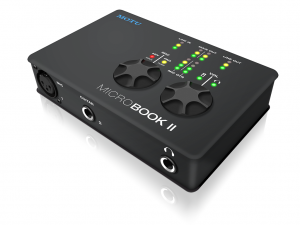MOTU Announces MicroBook II Audio Interface
MOTU has followed up NAMM by being the first with a significant post-show product news: Today the company announced the MicroBook II, an updated version of the compact, studio-grade audio interface for Mac or PC.
Shipping in the spring of 2012, the MicroBook II will retail for $269 USD (the same price as its predecessor), providing users with a personal 4 x 6 recording studio that features professional I/O and monitor mixing.
The MicroBook II comes in a compact, rugged cast metal case suitable for mobile recording, personal studio tracking, laptop-based DJ-ing, and myriad other recording/playback activities.
Sized at 5.5 x 3.5 x 1.25 inches, the bus-powered MicroBook II has all the features of the original model, plus hands-on volume control, USB 2.0 connectivity for low-latency performance, more simultaneous outputs (six), an XLR mic input, and support for 96 kHz recording and playback.
MOTU provides these additional details about MicroBook II:
“I/O engineered for sound quality
The four inputs (mic, hi-Z guitar, and stereo balanced line in) can be recorded simultaneously. The mic preamp delivers neutral coloration and pristine sound, with 20 dB pad and 48V phantom power for condenser mics.
Engineered for exceptional audio quality, the MicroBook II includes balanced analog connectors and digitally controlled analog trim. Input trim is controlled separately from input mix volume, so that users never have to sacrifice sound quality for a balanced mix.
The MicroBook II provides six channels of computer output on eight physical outputs (four pairs): balanced TRS quarter-inch main outs, stereo “mini” line out, S/PDIF digital out, and phones (on a stereo quarter-inch jack). The S/PDIF digital output always mirrors the main outs.
Advanced features
Internal CueMix mixing and routing features let users program a different stereo mix for each output pair, consisting of any combination of live inputs and host audio tracks. Alternately, users can send the same mix to multiple outputs, or choose a separate output for the MicroBook’s built-in test tone generator or white and pink noise generator.
The driver provides an extra input and output pair for routing complete mixes back to the computer host, for scoping audio streams with the analysis tools in the included CueMix FX software, and for routing virtual instrument (or other host) output to the MicroBook II mixer.
On-board effects include modeled analog EQ and compression, which can be applied with near-zero latency (in the hardware) to live inputs.
MicroBook feature highlights
– 4-input, 6-output bus-powered “plug-and-play” USB 2.0 audio interface for Mac and Windows.
– 6 x 8 physical input/output channels.
– 8-bus digital mixer to route and mix live inputs with computer tracks.
– Pre-amp equipped mic input with Precision Digital Trim™ 48V phantom power, and 20 dB pad.
– Hi-Z guitar input with Precision Digital Trim.
– Stereo line level analog input (balanced TRS quarter-inch or stereo mini).
– Stereo balanced TRS quarter-inch line level main outs.
– Stereo eighth-inch “mini” line level out.
– S/PDIF digital out (duplicates main out).
– Headphones output on quarter-inch stereo jack with independent volume control.
– Digitally controlled analog trim for all analog inputs.
– Digital trim for all outputs.
– Output volume digital rotary encoder. Push to cycle among three modes: main out, phones, or both.
– Mic input digital rotary encoder for adjusting trim level, 48V and pad.
– Dedicated 3- or 4-segment LED meters for all inputs and outputs.
– CueMix FX no-latency mixing and monitoring with EQ and dynamics processing.
– 7-band parametric EQ and compression.
– Test tone and white/pink noise generator.
– Support for recording and playback at 2x sample rates (88.2 and 96 kHz).
– Advanced audio analysis software tools, including FFT display, spectrogram “waterfall” display, oscilloscope, X-Y plot, and phase torch.
– Industry standard Mac and Windows audio drivers (Core Audio, Wave, and ASIO) for across-the-board compatibility.
– Compatible with all current and recent generation Macs and PCs.
– Includes AudioDesk DAW software, USB cable, and mic cable adapter.”







